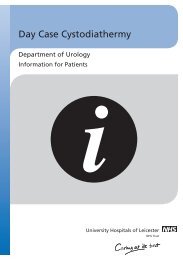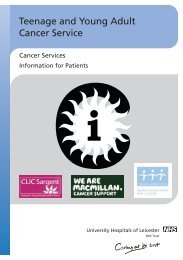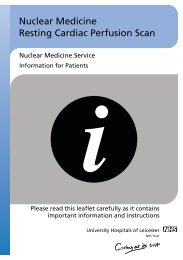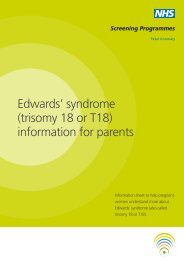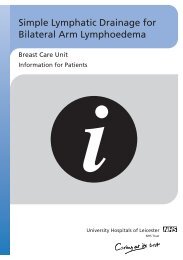Total Body Irradiation (TBI) - Library - University Hospitals of ...
Total Body Irradiation (TBI) - Library - University Hospitals of ...
Total Body Irradiation (TBI) - Library - University Hospitals of ...
Create successful ePaper yourself
Turn your PDF publications into a flip-book with our unique Google optimized e-Paper software.
<strong>Total</strong> <strong>Body</strong> <strong>Irradiation</strong> (<strong>TBI</strong>)Directorate <strong>of</strong> Cancer Services and Clinical HaematologyInformation for PatientsC i<strong>University</strong> <strong>Hospitals</strong> <strong>of</strong> LeicesterNHS Trust
What is <strong>Total</strong> <strong>Body</strong> <strong>Irradiation</strong> (<strong>TBI</strong>)?<strong>Total</strong> body irradiation (<strong>TBI</strong>) is radiotherapy (x-ray treatment) tothe whole body.Radiation has more effect on your bone marrow than on almostany other part <strong>of</strong> your body. This makes it very effective forpatients undergoing bone marrow transplantation.Having <strong>TBI</strong> as part <strong>of</strong> your treatment means that your marrowcells (both normal and abnormal) can be cleared to make way forthe new marrow from your donor, more effectively and withlower doses <strong>of</strong> chemotherapy than if you just had chemotherapyby itself.Radiotherapy is just like having an x-ray – you cannot feelanything happening. You will be staying on the Bone MarrowTransplant Unit (BMTU) and will come down to the radiotherapydepartment for a course <strong>of</strong> treatment over consecutive days. Howmany days you need to come to the Radiotherapy Departmentwill be discussed with you before you start treatment.How is it done?Before you come into hospital for your transplant, we need toprepare for your <strong>TBI</strong> by doing a ‘dummy run’ – this means givingyou a small ‘test’ dose <strong>of</strong> radiation to the whole body.Getting you into a stable position, and marking all the measuringpoints where we want them, takes half an hour or so the firsttime. This is done in a room called the ‘simulator’, by therapyradiographers, physicists and your doctor.2
How is it done? (continued)You will have a chest x-ray taken here as well, to record theposition <strong>of</strong> your arms and the measuring points on your chest.Then you will be taken to the treatment machine for your testdose. This is a very low dose and should not cause any aftereffects.Treatment is given using a radiotherapy machine (LinearAccelerator or LINAC) which can produce a wide x-ray beam tocover your whole body.You lie on your back, opposite the machine, on a trolley which isturned round half way through each treatment so you get halfthe dose from your right and half from your left, to make it even.Your arms will usually be folded across your chest and kneesslightly bent but comfortably supported.You will need to wear only a hospital gown and pants, and youmust remove any jewellery. You will be covered as much aspossible by a sheet or blanket and kept warm.Several very small measuring devices will be taped onto your skinat points all down your left side, to measure how the radiationdose varies in different parts <strong>of</strong> your body. We take thesemeasurements each time you have treatment, and use them tomake adjustments so that the overall dose is as even as possible.Exactly the same points are used each time.One point will be marked permanently by making a tiny tattoowith a sterile needle; the others will be marked with a felt pen, sodo your best not to wash them <strong>of</strong>f.One way <strong>of</strong> adjusting the dose is to alter the position <strong>of</strong> yourarms, so for one or more <strong>of</strong> your treatments you will have yourarms above your head rather than across your chest.3
How is it done? (continued)Another way is to use a screen <strong>of</strong> varying thickness, which will beplaced close to your side, between you and the treatmentmachine.You will be in the treatment room on your own while the x-raybeam is on, and it takes about ten minutes to treat each side. Youcan bring a CD to listen to if you like.What are the side effects <strong>of</strong> <strong>TBI</strong>?Short term side effectsNausea, vomiting, diarrhoea and a sore mouth are common.These side effects could start after one treatment, but are morelikely as treatment goes on. You will be <strong>of</strong>fered preventative andongoing medication to control this.Occasionally there is swelling and discomfort <strong>of</strong> the salivary glandsin your cheeks for a few days after the end <strong>of</strong> radiotherapy.Food may taste different or tasteless, and this can take longer tocome back to normal.A temporary redness or rash is common, and the skin may be dryand itchy. The following tips should help to reduce this:• Wash or shower in warm water, and pat your skin dry with as<strong>of</strong>t towel• Use Simple® soap or baby soap, do not use any perfumedsoaps, shower gels or shampoo• Use aqueous cream to prevent dryness and itching• Use extra sun screen if you are going out in the sun for at leastsix months after treatment.4
What are the side effects <strong>of</strong> <strong>TBI</strong>? (continued)You may experience some hair loss.Tiredness and feeling weak from radiotherapy should last a weekor two, but the chemotherapy effects add to this and you will nothave much energy until your new marrow is working well. Youmay suffer from feeling sleepy for up to six weeks aftertreatment. This is usually a feeling <strong>of</strong> tiredness, but sometimesresults in a constant desire to sleep. This will pass.Long term side effectsThis form <strong>of</strong> treatment <strong>of</strong>ten leads to permanent infertility due tothe effects <strong>of</strong> treatment on reproductive cells. You will have theopportunity to discuss this further with your doctor.The lenses <strong>of</strong> the eyes are sensitive to radiation and about 20% <strong>of</strong>people get cataracts (where the lens goes cloudy and you can’tsee through it properly). However, this does not usually happenuntil eighteen months or more after treatment. Cataracts can beremoved and the rest <strong>of</strong> the eye should not be affected.There is an increased risk <strong>of</strong> other tumours later in life for peoplewho have had a transplant. This is partly due to chemotherapyand reduced immunity, and partly to radiotherapy. Radiotherapyis given to ensure the best chance <strong>of</strong> a cure.5
Contact informationYour carer in Radiotherapy is:Contact Number:6
Questions I would like to ask7
If you would like this information in anotherlanguage or format, please contact theservice equality manager on 0116 250 2959Radiotherapy Patient Information Group <strong>TBI</strong> Edition 4: November 2011 Reviewed: November 2013For review: December 2015 (Moody)12137318KR CAN155-1213




